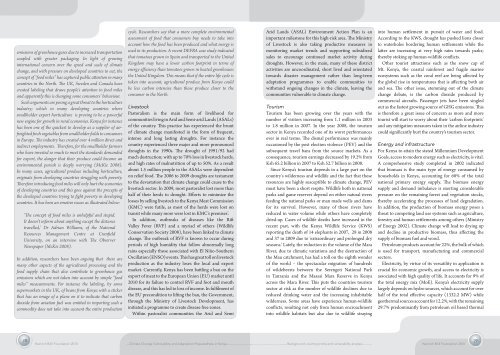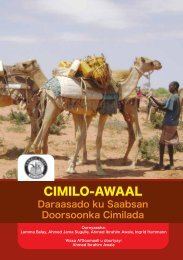Climate Change Vulnerability and Adaptation Preparedness in Kenya
Climate Change Vulnerability and Adaptation Preparedness in Kenya
Climate Change Vulnerability and Adaptation Preparedness in Kenya
Create successful ePaper yourself
Turn your PDF publications into a flip-book with our unique Google optimized e-Paper software.
emissions of greenhouse gases due to <strong>in</strong>creased transportation<br />
coupled with greater packag<strong>in</strong>g. In light of grow<strong>in</strong>g<br />
<strong>in</strong>ternational concern over the speed <strong>and</strong> scale of climate<br />
change, <strong>and</strong> with pressure on developed countries to act, the<br />
concept of “food miles” has captured public att ention <strong>in</strong> many<br />
countries <strong>in</strong> the North. Th e UK, Sweden <strong>and</strong> Canada have<br />
created label<strong>in</strong>g that draws people’s att ention to food miles<br />
<strong>and</strong> apparently this is chang<strong>in</strong>g some consumers’ behaviour.<br />
Such arguments are pos<strong>in</strong>g a great threat to the horticulture<br />
<strong>in</strong>dustry; which <strong>in</strong> many develop<strong>in</strong>g countries where<br />
smallholder export horticulture is prov<strong>in</strong>g to be a powerful<br />
new eng<strong>in</strong>e for growth <strong>in</strong> rural economies. <strong>Kenya</strong> for <strong>in</strong>stance<br />
has been one of the quickest to develop as a supplier of airfr<br />
eighted fr esh vegetables fr om smallholder fi elds to consumers<br />
<strong>in</strong> Europe. Th e <strong>in</strong>dustry has created over 4 million direct <strong>and</strong><br />
<strong>in</strong>direct employments. Th erefore, for the smallholder farmers<br />
who have <strong>in</strong>vested so much to meet the st<strong>and</strong>ards dem<strong>and</strong>ed<br />
for export, the danger that their produce could become an<br />
environmental pariah is deeply worry<strong>in</strong>g (McKie 2008).<br />
In many cases, agricultural produce <strong>in</strong>clud<strong>in</strong>g horticulture,<br />
orig<strong>in</strong>ate fr om develop<strong>in</strong>g countries struggl<strong>in</strong>g with poverty.<br />
Th erefore <strong>in</strong>troduc<strong>in</strong>g food miles will only hurt the economies<br />
of develop<strong>in</strong>g countries <strong>and</strong> this goes aga<strong>in</strong>st the precepts of<br />
the developed countries try<strong>in</strong>g to fi ght poverty <strong>in</strong> develop<strong>in</strong>g<br />
countries. It has been an emotive issues as illustrated below:<br />
‘Th e concept of food miles is unhelpful <strong>and</strong> stupid.<br />
It doesn’t <strong>in</strong>form about anyth<strong>in</strong>g except the distance<br />
travelled,’ Dr Adrian Williams, of the National<br />
Resources Management Centre at Cranfi eld<br />
University, on an <strong>in</strong>terview with Th e Observer<br />
Newspaper (McKie 2008).<br />
In addition, researchers have been argu<strong>in</strong>g that there are<br />
many other aspects of the agricultural process<strong>in</strong>g <strong>and</strong> the<br />
food supply cha<strong>in</strong> that also contribute to greenhouse gas<br />
emissions which are not taken <strong>in</strong>to account by simple “food<br />
miles” measurements. For <strong>in</strong>stance the label<strong>in</strong>g, by some<br />
supermarkets <strong>in</strong> the UK, of beans fr om <strong>Kenya</strong> with a sticker<br />
that has an image of a plane on it to <strong>in</strong>dicate that carbon<br />
dioxide fr om aviation fuel was emitt ed <strong>in</strong> import<strong>in</strong>g such a<br />
commodity does not take <strong>in</strong>to account the entire production<br />
28<br />
cycle. Researchers say that a more complete environmental<br />
assessment of food that consumers buy needs to take <strong>in</strong>to<br />
account how the food has been produced <strong>and</strong> what energy is<br />
used <strong>in</strong> its production. A recent DEFRA case study <strong>in</strong>dicated<br />
that tomatoes grown <strong>in</strong> Spa<strong>in</strong> <strong>and</strong> transported to the United<br />
K<strong>in</strong>gdom may have a lower carbon footpr<strong>in</strong>t <strong>in</strong> terms of<br />
energy effi ciency than tomatoes grown <strong>in</strong> heated greenhouses<br />
the United K<strong>in</strong>gdom. Th is means that if the entire life cycle is<br />
taken <strong>in</strong>to account, agricultural produce fr om <strong>Kenya</strong> could<br />
be less carbon <strong>in</strong>tensive than those produce closer to the<br />
consumer <strong>in</strong> the North.<br />
Livestock<br />
Pastoralism is the ma<strong>in</strong> form of livelihood for<br />
communities liv<strong>in</strong>g <strong>in</strong> Arid <strong>and</strong> Semi-arid L<strong>and</strong>s (ASALs)<br />
of the country. Th is practice has experienced the brunt<br />
of climate change manifested <strong>in</strong> the form of frequent,<br />
<strong>in</strong>tense <strong>and</strong> long last<strong>in</strong>g droughts. For <strong>in</strong>stance the<br />
country experienced three major <strong>and</strong> more pronounced<br />
droughts <strong>in</strong> the 1990s. Th e drought of 1991/92 had<br />
much destruction; with up to 70% loss <strong>in</strong> livestock herds,<br />
<strong>and</strong> high rates of malnutrition of up to 50%. As a result<br />
about 1.5 million people <strong>in</strong> the ASALs were dependent<br />
on relief food. Th e 2006 to 2009 droughts are testament<br />
to the devastation that climate change could cause to the<br />
livestock sector. In 2009, most pastoralist lost more than<br />
half of their herds to drought. Eff orts to m<strong>in</strong>imize the<br />
losses by sell<strong>in</strong>g livestock to the <strong>Kenya</strong> Meat Commission<br />
(KMC) were futile, as most of the herds were lost on<br />
transit while many more were lost <strong>in</strong> KMC’s premises’.<br />
In addition, outbreaks of diseases like the Rift<br />
Valley Fever (RVF) <strong>and</strong> a myriad of others (Wildlife<br />
Conservation Society 2008), have been l<strong>in</strong>ked to climate<br />
change. Th e outbreak of RVF is known to occur dur<strong>in</strong>g<br />
periods of high humidity that follow abnormally long<br />
ra<strong>in</strong>s especially those associated with El Niño-Southern<br />
Oscillation (ENSO) events. Th is has great toll on livestock<br />
production as the <strong>in</strong>dustry loses the local <strong>and</strong> export<br />
market. Currently, <strong>Kenya</strong> has been batt l<strong>in</strong>g a ban on the<br />
export of meat to the European Union (EU) market until<br />
2010 for its failure to control RVF <strong>and</strong> foot <strong>and</strong> mouth<br />
disease, <strong>and</strong> this has led to loss of <strong>in</strong>come. In fulfi lment of<br />
the EU precondition to lift <strong>in</strong>g the ban, the Government,<br />
through the M<strong>in</strong>istry of Livestock Development, has<br />
<strong>in</strong>itiated a programme to create disease free zones.<br />
With<strong>in</strong> pastoralist communities the Arid <strong>and</strong> Semi<br />
Arid L<strong>and</strong>s (ASAL) Environment Action Plan is an<br />
important milestone for this high-risk area. Th e M<strong>in</strong>istry<br />
of Livestock is also tak<strong>in</strong>g productive measures <strong>in</strong><br />
monitor<strong>in</strong>g market trends <strong>and</strong> support<strong>in</strong>g subsidized<br />
sales to encourage cont<strong>in</strong>ued market activity dur<strong>in</strong>g<br />
droughts. However, <strong>in</strong> the ma<strong>in</strong>, many of these district<br />
activities are uncoord<strong>in</strong>ated, short lived <strong>and</strong> orientated<br />
towards disaster management rather than long-term<br />
adaptation programmes to enable communities to<br />
withst<strong>and</strong> ongo<strong>in</strong>g changes <strong>in</strong> the climate, leav<strong>in</strong>g the<br />
communities vulnerable to climate change.<br />
Tourism<br />
Tourism has been grow<strong>in</strong>g over the years with the<br />
number of visitors <strong>in</strong>creas<strong>in</strong>g from 1.1 million <strong>in</strong> 2003<br />
to 1.8 million <strong>in</strong> 2007. In the year 2008, the tourism<br />
sector <strong>in</strong> <strong>Kenya</strong> recorded one of its worst performances<br />
ever <strong>in</strong> real terms. Th e dismal performance was ma<strong>in</strong>ly<br />
occasioned by the post election violence (PEV) <strong>and</strong> the<br />
subsequent travel bans from the source markets. As a<br />
consequence, tourism earn<strong>in</strong>gs decreased by 19.2% from<br />
Ksh 65.2 billion <strong>in</strong> 2007 to Ksh 52.7 billion <strong>in</strong> 2008.<br />
S<strong>in</strong>ce <strong>Kenya</strong>’s tourism depends <strong>in</strong> a large part on the<br />
country’s wilderness <strong>and</strong> wildlife <strong>and</strong> the fact that these<br />
resources are highly susceptible to climate change, PEV<br />
must have been a short respite. Wildlife both <strong>in</strong> national<br />
parks <strong>and</strong> game reserves depend on either natural rivers<br />
feed<strong>in</strong>g the national parks or man made wells <strong>and</strong> dams<br />
for its survival. However, many of these rivers have<br />
reduced <strong>in</strong> water volume while others have completely<br />
dried-up. Cases of wildlife deaths have <strong>in</strong>creased <strong>in</strong> the<br />
recent past, with the <strong>Kenya</strong> Wildlife Service (KWS)<br />
report<strong>in</strong>g the death of 14 elephants <strong>in</strong> 2007, 28 <strong>in</strong> 2008<br />
<strong>and</strong> 37 <strong>in</strong> 2009 due to ‘extraord<strong>in</strong>ary <strong>and</strong> prolonged dry<br />
seasons.’ Lately, the reduction <strong>in</strong> the volume of the Mara<br />
River, due to climatic variations <strong>and</strong> the destruction of<br />
the Mau catchment, has had a toll on the eighth wonder<br />
of the world – the spectacular migration of hundreds<br />
of wildebeests between the Serengeti National Park<br />
<strong>in</strong> Tanzania <strong>and</strong> the Maasai Mara Reserve <strong>in</strong> <strong>Kenya</strong><br />
across the Mara River. Th is puts the countries tourism<br />
sector at risk as the number of wildlife decl<strong>in</strong>es due to<br />
reduced dr<strong>in</strong>k<strong>in</strong>g water <strong>and</strong> the <strong>in</strong>creas<strong>in</strong>g <strong>in</strong>habitable<br />
wilderness. Some areas have experience human-wildlife<br />
confl icts, result<strong>in</strong>g not only from human encroachment<br />
<strong>in</strong>to wildlife habitats but also due to wildlife stray<strong>in</strong>g<br />
He<strong>in</strong>rich Böll Foundation 2010 --<strong>Climate</strong> <strong>Change</strong> <strong>Vulnerability</strong> <strong>and</strong> <strong>Adaptation</strong> <strong>Preparedness</strong> <strong>in</strong> <strong>Kenya</strong>--------------------- -----------------------------------Background: -<br />
country profi le <strong>and</strong> vulnerability analysis---------<br />
<strong>in</strong>to human sett lement <strong>in</strong> pursuit of water <strong>and</strong> food.<br />
Accord<strong>in</strong>g to the KWS, drought has pushed lions closer<br />
to waterholes border<strong>in</strong>g human sett lements while the<br />
latt er are <strong>in</strong>creas<strong>in</strong>g at very high rates towards parks;<br />
thereby stok<strong>in</strong>g up human-wildlife confl icts.<br />
Other tourist att ractions such as the snow cap of<br />
Mt. <strong>Kenya</strong>, the coastal ra<strong>in</strong>forest <strong>and</strong> fragile mar<strong>in</strong>e<br />
ecosystems such as the coral reef are be<strong>in</strong>g aff ected by<br />
the global rise <strong>in</strong> temperatures that is aff ect<strong>in</strong>g both air<br />
<strong>and</strong> sea. Th e other issue, stemm<strong>in</strong>g out of the climate<br />
change debate, is the carbon dioxide produced by<br />
commercial aircraft s. Passenger jets have been s<strong>in</strong>gled<br />
out as the fastest grow<strong>in</strong>g source of GHG emissions. Th is<br />
is therefore a great issue of concern as more <strong>and</strong> more<br />
tourist will start to worry about their ‘carbon footpr<strong>in</strong>ts’<br />
<strong>and</strong> any mitigation measures taken <strong>in</strong> the airl<strong>in</strong>e <strong>in</strong>dustry<br />
could signifi cantly hurt the country’s tourism sector.<br />
Energy <strong>and</strong> <strong>in</strong>frastructure<br />
For <strong>Kenya</strong> to att a<strong>in</strong> the stated Millennium Development<br />
Goals, access to modern energy such as electricity, is vital.<br />
A comprehensive study completed <strong>in</strong> 2002 <strong>in</strong>dicated<br />
that biomass is the ma<strong>in</strong> type of energy consumed by<br />
households <strong>in</strong> <strong>Kenya</strong>, account<strong>in</strong>g for 68% of the total<br />
national primary energy supply. Th e biomass energy<br />
supply <strong>and</strong> dem<strong>and</strong> imbalance is exert<strong>in</strong>g considerable<br />
pressure on the rema<strong>in</strong><strong>in</strong>g forest <strong>and</strong> vegetation stocks,<br />
thereby accelerat<strong>in</strong>g the processes of l<strong>and</strong> degradation.<br />
In addition, the production of biomass energy poses a<br />
threat to compet<strong>in</strong>g l<strong>and</strong> use systems such as agriculture,<br />
forestry <strong>and</strong> human sett lements among others (M<strong>in</strong>istry<br />
of Energy 2002). <strong>Climate</strong> change will lead to dry<strong>in</strong>g up<br />
<strong>and</strong> decl<strong>in</strong>e <strong>in</strong> productive biomass, thus aff ect<strong>in</strong>g the<br />
supply of biomass fuel <strong>and</strong> wood.<br />
Petroleum products account for 22%, the bulk of which<br />
is used for transport, manufactur<strong>in</strong>g <strong>and</strong> commercial<br />
sectors.<br />
Electricity, by virtue of its versatility <strong>in</strong> application is<br />
crucial for economic growth, <strong>and</strong> access to electricity is<br />
associated with high quality of life. It accounts for 9% of<br />
the total energy mix (MoE). <strong>Kenya</strong>’s electricity supply<br />
largely depends on hydro sources, which account for over<br />
half of the total eff ective capacity (1332.2 MW) while<br />
geothermal sources account for 12.2%, with the rema<strong>in</strong><strong>in</strong>g<br />
29.7% predom<strong>in</strong>antly from petroleum oil based thermal<br />
29




